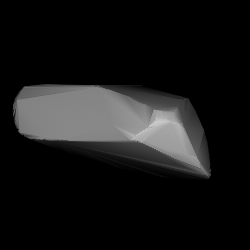 Modelled shape of Banachiewicza | |
| Discovery[1] | |
|---|---|
| Discovered by | S. Arend |
| Discovery site | Uccle Obs. |
| Discovery date | 25 August 1933 |
| Designations | |
| (1286) Banachiewicza | |
Named after | Tadeusz Banachiewicz[2] (Polish astronomer) |
| 1933 QH · 1928 SE 1954 UJ | |
| main-belt · (outer)[3] Eos[4] | |
| Orbital characteristics[1] | |
| Epoch 4 September 2017 (JD 2458000.5) | |
| Uncertainty parameter 0 | |
| Observation arc | 88.78 yr (32,428 days) |
| Aphelion | 3.2926 AU |
| Perihelion | 2.7553 AU |
| 3.0240 AU | |
| Eccentricity | 0.0888 |
| 5.26 yr (1,921 days) | |
| 29.653° | |
| 0° 11m 14.64s / day | |
| Inclination | 9.7486° |
| 200.46° | |
| 107.58° | |
| Physical characteristics | |
| 8.631±0.001 h[8] | |
Pole ecliptic latitude | |
| Tholen = S[1][3] B–V = 0.850[1] U–B = 0.430[1] | |
| 10.626±0.009 (R)[10] · 10.88[1][3][6][7] | |
1286 Banachiewicza (prov. designation: 1933 QH) is an elongated Eos asteroid from the outer regions of the asteroid belt. It was discovered on 25 August 1933, by Belgian astronomer Sylvain Arend at the Royal Observatory of Belgium in Uccle.[11] The stony S-type asteroid has a rotation period of 8.6 hours and measures approximately 21 kilometers (13 miles) in diameter. It was named after Polish astronomer Tadeusz Banachiewicz.[2]
- ^ a b c d e f Cite error: The named reference
jpldatawas invoked but never defined (see the help page). - ^ a b Cite error: The named reference
springerwas invoked but never defined (see the help page). - ^ a b c Cite error: The named reference
lcdbwas invoked but never defined (see the help page). - ^ Cite error: The named reference
Ferretwas invoked but never defined (see the help page). - ^ a b Cite error: The named reference
Masiero-2014was invoked but never defined (see the help page). - ^ a b c Cite error: The named reference
AKARIwas invoked but never defined (see the help page). - ^ a b c Cite error: The named reference
WISEwas invoked but never defined (see the help page). - ^ Cite error: The named reference
geneva-obswas invoked but never defined (see the help page). - ^ a b Cite error: The named reference
Hanus-2013cwas invoked but never defined (see the help page). - ^ Cite error: The named reference
Waszczak-2015was invoked but never defined (see the help page). - ^ Cite error: The named reference
MPC-objectwas invoked but never defined (see the help page).